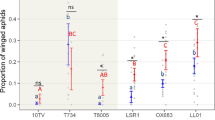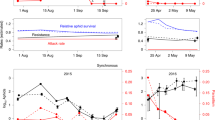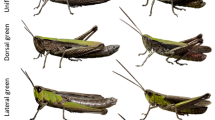Abstract
Although polymorphism is a widespread phenomenon that hasbeen recognized for nearly two centuries, the basic mechanisms maintaining most polymorphisms in nature are unknown1,2. We present evidence that a polymorphism can be maintained exclusively by balanced selection from two predatory species. For fieldand laboratory experiments, we used the pea aphid, Acyrthosiphon pisum, which occurs as ‘green’ and ‘red’ colour morphs, and two species that attack pea aphids, the parasitoid Aphidius ervi and the predator Coccinella septempunctata. We found that when parasitism rates in the field were high relative to predation rates, the proportion of red morphs increased relative to green morphs, whereas the converse was true when predation rates were high relative to parasitism rates. Detailed laboratory and field studies confirmed that green morphs suffer higher rates of parasitism than red morphs, whereas red morphs are more likely to be preyed on by predators than green morphs are. We present a mathematical model that demonstrates that biased density-dependent parasitism and/or predation on different morphs is sufficient to maintain the colour polymorphism in the population. Our findings support an important role for predation in the maintenance of genetic diversity.
This is a preview of subscription content, access via your institution
Access options
Subscribe to this journal
Receive 51 print issues and online access
$199.00 per year
only $3.90 per issue
Buy this article
- Purchase on Springer Link
- Instant access to full article PDF
Prices may be subject to local taxes which are calculated during checkout


Similar content being viewed by others
References
Falconer, D. S. & McKay, R. Introduction to Quantitative Genetics 3rd edn (Longman, New York, (1996)).
Rousseau, J. J. Letters on the Elements of Botany (English translation, (1785)).
Araya, J. E., Cambron, S. E. & Ratcliffe, R. H. Development and reproduction of two color forms of English grain aphid (Homoptera: Aphididae). Envir. Entomol. 25, 366–369 (1996).
Henter, H. J. & Via, S. The potential for coevolution in a host-parasitoid system. I. Genetic variation within an aphid population in susceptibility to a parasitic wasp. Evolution 49, 427–438 (1995).
Müller, F. P. Differential alarm pheromone responses between strains of the aphid Acyrthosiphon pisum. Entomol. Exp. Appl. 34, 347–348 (1983).
Lowe, H. J. B. Resistance and susceptibility to colour forms of the aphid Sitobion avenae in spring and winter wheats (Triticum aestivum). Ann. Appl. Biol. 99, 87–98 (1981).
Price, P. W. Insect Ecology 2nd edn (Wiley-Interscience, New York, (1984)).
Gutierrez, A. P., Hagen, K. S. & Ellis, C. K. in Critical Issues in Biological Control (eds Mackauer, M., Ehler, L. E. & Roland, J.) 81–109 (Intercept, Andover, (1990)).
Frazer, B. D., Gilbert, N., Ives, P. M. & Raworth, D. A. Predator reproduction and the overall predator-prey relationship. Can. Entomol. 113, 1015–1024 (1981).
Phoofolo, M. W. & Obrycki, J. J. Comparative life-history studies of Neartic and Paleartic populations of Coccinella septempunctata (Coleoptera: Coccinellidae). Envir. Entomol. 24, 581–587 (1995).
Thiboldeaux, R. L., Hutchison, W. D. & Hogg, D. B. Species composition of pea aphid (Homoptera: Aphididae) primary and secondary parasitoids in Wisconsin. Can. Entomol. 119, 1055–1057 (1987).
Markkula, M. Studies on the pea aphid, A. pisum, with special reference to the differences in the biology of the green and red forms. Ann. Agri. Fenniae 2 (suppl. 1), 1–30 (1963).
Michaud, J. P. & Mackauer, M. The use of visual cues in host evaluation by aphidiid wasps. II. Comparison between Ephedrus californicus, Monoctonus paulensis, and Praon pequodorum. Entomol. Exp. Appl. 74, 267–275 (1995).
Losey, J. E. & Denno, R. F. The escape response of pea aphids to foliar-foraging predators: Factors affecting dropping behavior. Ecol. Entomol. (in the press).
Nakamuta, K. Visual orientation of a ladybeetle, Coccinella septempunctata L., (Coleoptera: Coccinellidae), towards its prey. Appl. Entomol. Zool. 19, 82–86 (1984).
Battaglia, D., Pennacchio, F., Romano, A. & Tranfaglia, A. The role of physical cues in the regulation of host recognition and acceptance behavior of Aphidius ervi haliday (Hymenoptera: Braconidae). J. Insect Behav. 8, 739–750 (1995).
Ives, A. R., Kareiva, K. & Perry, R. Response of a predator to variation in prey density at three hierarchical scales: lady beetles feeding on aphids. Ecology 74, 1929–1938 (1993).
Honek, A. Factors which determine the composition of field communities of adult aphidophagous Coccinellidae (Coleoptera). Zeit. Angew. Entomol. 94, 157–168 (1982).
Helenius, J. Conventional and organic cropping systems at Suitia (Finland): VI. Insect populations in barley. J. Agri. Sci. Finland 62, 349–356 (1990).
Lewontin, R. C. The Genetic Basis of Evolutionary Change (Columbia University, New York, (1974)).
Maynard Smith, J. The Theory of Evolution 3rd edn (Penguin, Harmondsworth, Middlesex, (1975)).
Brakefield, P. M. in The Scientific Management of Temperate Communities for Conservation (eds Spellerberg, I. F., Goldsmith, F. B. & Morris, M. G.) 45–79 (Blackwell Scientific, Oxford, (1991)).
Berry, R. J. in The Scientific Management of Animal and Plant Communities for Conservation (eds Duffey, E. & Watt, A. S.) 177–206 (Blackwell Scientific, Oxford, (1971)).
Samways, M. J. Insect Conservation Biology (Chapman and Hall, London, (1994)).
Acknowledgements
We thank D. Hogg, R. ffrench-Constant, T. Garland, M. Strand, M. Hamill, J.Foufopoulos, E. Klopfer and J. Klug for comments on earlier versions of the manuscript. This work was supported by a grant from the US Department of Agriculture to A.R.I.
Author information
Authors and Affiliations
Corresponding author
Rights and permissions
About this article
Cite this article
Losey, J., Harmon, J., Ballantyne, F. et al. A polymorphism maintained by opposite patterns of parasitism and predation. Nature 388, 269–272 (1997). https://doi.org/10.1038/40849
Received:
Accepted:
Issue Date:
DOI: https://doi.org/10.1038/40849
This article is cited by
-
Behavioral responses of Nesidiocoris tenuis (Reuter) to different monochromatic lights and light intensities
Journal of Plant Diseases and Protection (2024)
-
Advances in genome sequencing reveal changes in gene content that contribute to arthropod macroevolution
Development Genes and Evolution (2023)
-
Body-color plasticity of the English grain aphid in response to light in both laboratory and field conditions
Evolutionary Ecology (2021)
-
First description of color variations in the annual killifish Millerichthys robustus, and preliminary observations about its geographical distribution
Environmental Biology of Fishes (2021)
-
Urbanisation alters ecological interactions: Ant mutualists increase and specialist insect predators decrease on an urban gradient
Scientific Reports (2020)
Comments
By submitting a comment you agree to abide by our Terms and Community Guidelines. If you find something abusive or that does not comply with our terms or guidelines please flag it as inappropriate.



